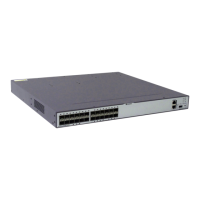Step 5 Run:
filter-policy { acl-number | acl-name acl-name | ip-prefix ip-prefix-name } export
[ protocol [ process-id ] ]
MBGP routing policy is configured to filter advertised routes.
The parameters of the command are explained as follows:
l acl-number and acl-name acl-name: specifies the address filtering table.
l ip-prefix-name: specifies the address prefix list.
l export [ protocol [ process-id ] ]: filters the routes sent to any MBGP peer. In fact, the filtering
is performed when the local routes are imported to the MBGP routing table. This command
is used to import the local routes that pass the filtering to the MBGP routing table, and then
advertise the routing information in the MBGP routing table.
NOTE
process-id specifies the number of the unicast routing protocol. When the unicast routing protocol is IS-
IS, OSPR or RIP, you need to set process-id.
----End
9.5.3 Configuring the Route Filtering Policy Based on Route-policy
By configuring an MBGP route-policy, you can flexibly filter routes.
Context
Do as follows on the switch configured with an MBGP peer:
NOTE
The configuration is optional. By default, the route filtering policy based on route-policy is not configured.
Procedure
Step 1 Run:
system-view
The system view is displayed.
Step 2 Run:
bgp as-number
The BGP view is displayed.
Step 3 Run:
ipv4-family multicast
The BGP-IPv4 multicast address family view is displayed.
Step 4 Run:
peer { ipv4-address | group-name } route-policy route-policy-name { import |
export }
The MBGP routing policy based on route-policy is configured to control the route exchange
with a specified remote MBGP peer.
The parameters of the command are explained as follows:
S6700 Series Ethernet Switches
Configuration Guide - IP Routing 9 MBGP Configuration
Issue 01 (2012-03-15) Huawei Proprietary and Confidential
Copyright © Huawei Technologies Co., Ltd.
568

